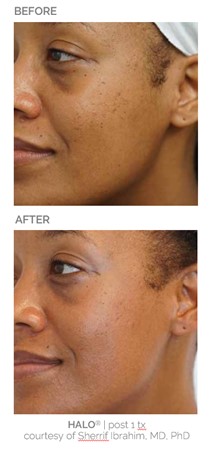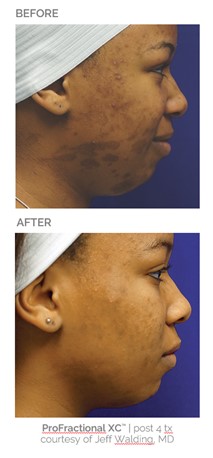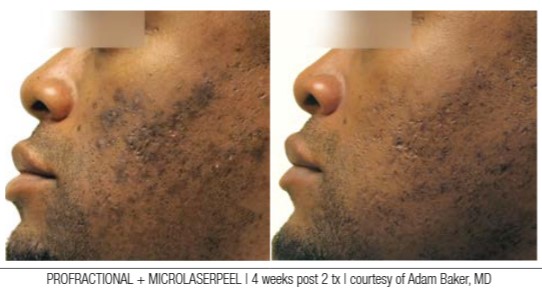July 19, 2023—Have your patients with deeper skin tones expressed concern about getting laser treatments, wondering, ‘Is this laser safe for me?’ 1
Their concerns are valid.
With less research from clinical trials to help gauge how lasers impact darker skin tones, patients of color have long believed that laser treatments weren’t an aesthetic option for them.1
Dija Ayodele, skincare expert and author of Black Skin: The Definitive Skincare Guide, says this isn’t true. There are laser treatments appropriate for dark skin, but clinicians need the nuance and knowledge to apply the same laser treatments to different skin types.1
The good news is there’s already been a major shift towards inclusivity in the aesthetics industry.
According to the American Society of Plastic Surgeons statistics report, an increasing number of Americans of diverse ethnicities are having cosmetic procedures. Data shows that 1.78 million African American patients had cosmetic procedures in 2020, rising from 1.62 million in 2018. Hispanic, African American, and Asian patients in 2020 also represented a greater proportion of the total patient numbers having cosmetic surgery compared to 2019.2
With this trend expected to continue, debunking popular myths about treating dark skin will be key to helping medical aesthetics practices unlock a diverse patient demographic.
Myth #1: Skincare issues manifest the same on darker skin
According to a New York Times article, Dermatology Has a Problem with Skin Color, common skin conditions often appear differently on dark skin, yet physicians are mostly trained to diagnose them on white skin.3
Although there’s been progress, most textbooks for diagnosing skin disorders have far fewer images of skin conditions as they appear on people of color. This can lead to misdiagnoses because many key characteristics of skin disorders—like red patches and purple blotches—appear differently in people with different complexions.3
For example, when most people think of eczema, they think of how it appears on light skin—as a red, dry, and itchy rash. However, in dark skin, this redness may be difficult to see. Eczema flare-ups look darker brown, purple, or ash grey in color. 3
Oftentimes, doctors miss rosacea in Black patients because clinicians expect to see redness and visible blood vessels on the face, but red is not seen as much if the background skin color is brown. 3
In the world of medical laser aesthetics, medical professionals must first recognize the disease process in darker skin to make appropriate treatment recommendations.
Myth #2: Light and dark skin patients have the same skin concerns
While light and dark skin patients may share some common aesthetic skin concerns, dark skin patients are prone to the following:4
Hyperpigmentation and post-inflammatory hyperpigmentation (PIH)—Studies indicate a direct link between dark skin and the predisposition to develop PIH. PIH is significantly more frequent and severe in darkly pigmented skin.5
According to the Skin of Color Society, more than 65% of African American people experience symptoms of hyperpigmentation due to skin damage or irritation.6 Laser skin treatments such as HALO®, MOXI™, and ProFractional™ for skin types I-VI may be used alone or in combination to effectively address hyperpigmentation and other skin conditions in dark skin patients.



Melasma—Individuals of color, particularly women, are at increased risk for developing melasma. While clinicians know there is no cure for this skin condition, the visible signs associated with melasma can be treated with Sciton’s MOXI™ laser treatment for skin types I-VI. Clinicians typically recommend 3 MOXI treatments spaced 4 weeks apart and a skin maintenance regimen with Moxi.8
Keloid scars—Known for their dense, raised appearance, keloid scars tend to occur more commonly in skin of color, particularly in people of African descent. Laser treatments offer some of the best clinical responses in hypertrophic scars and keloids,9 including Sciton’s ProFractional laser for skin types I-VI. For dark skin types struggling with atrophic scarring from acne, studies have shown the efficacy of a YAG 1064 nm laser like Sciton’s ClearSilk® treatment in improving the appearance of scars.10
Dyschromia, alopecia, and seborrheic dermatitis—These skin conditions are found more frequently in patients with skin of color when compared with white patients. Dyschromia, or irregular skin discoloration resulting in either hyperpigmentation or hypopigmentation and seborrheic dermatitis, a skin condition that causes scaly patches mainly on the scalp, may be treated with a skin resurfacing laser treatment for all skin types, such as HALO.
Myth 3 #: Dark skin patients don’t need to wear sunscreen
The American Academy of Dermatology’s official position on sunscreen, echoed by the Food and Drug Administration, is that ‘everyone, regardless of skin type, should wear sunscreen.’11
Although dark skin is naturally more protective against harmful UV rays than fair skin—melanin provides a sun protection factor (SPF) of 13.4 in black skin, compared to 3.4 in white skin—people of all skin types can burn without sunscreen protection. The burn may not be visible, but it is still there. Dark skin patients can still get sunburn, skin cancer, and age prematurely. 10
All patients, including those with dark skin prone to dark spots and hyperpigmentation, are advised to stay out of direct sunlight and apply at least SPF 30 for the weeks preceding and following a laser treatment.
Myth # 4: Pre and post-care are the same for light and dark skin
The skin’s recovery process can look very different on skin of color. Clinicians need to be able to recognize these issues and tailor pre- and post-care appropriately.1
Theresa Reynolds, a multi-ethnic medical laser specialist and founder of AllSKN Aesthetics, tailors her pre- and post-care for each individual patient because dark skin, she says, reacts differently from light skin.
To learn more about treating skin of color with Sciton lasers from Theresa and Dr. Karan Lal, DO, FAAD, a double board certified pediatric and cosmetic dermatologist in Scottsdale, AZ, watch the Treating Skin of Color with Confidence webinar here.
Myth #5: Keep your marketing messaging generic
As the aesthetics industry aims to recognize and promote diversity, companies need to realign their messaging to be inclusive of patients of color. 1
According to Dija Ayodele, companies can use language in their marketing to let patients know laser treatments are appropriate for their skin with a simple statement like, “This laser treatment is suitable for dark skin. This is how [expectations, results, recovery, etc.] it will work on dark skin.” 1
Proper training and education for treating skin of color, product testing on darker skin types, and inclusive marketing messaging will become increasingly important in promoting diversity in a fast-changing industry.
Which Sciton laser treatments are right for your patients’ skin type?
At Sciton, a rigorous testing protocol ensures the efficacy and safety of laser treatments for patients of all skin tones, including darker skin.
Sciton’s clinical educators provide pre- and post-clinical training with treatment protocols for skin types I-VI as well as advanced clinical preceptorships.
To learn more about Sciton treatments by skin type, download Sciton’s Which Fitz Fits brochure.
References:
1Podcast 101: Dija Ayodele on why black skincare matters
2American Society of Plastic Surgeons, Plastic Surgery Statistics Report 2020
3New York Times: Dermatology Has a Problem With Skin Color
4How These 4 Skin Conditions Impact People of Color
